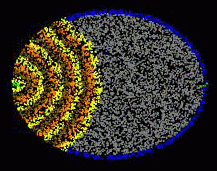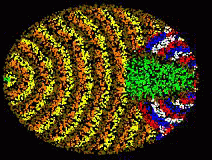 |
A Day in the Life of a Tube
Ron Weiss
|
 |
This page describes a simulation of the formation of a tube through
the cooperation of a large number of independent elements with only
local interactions. This is part of an attempt to understand how to
program morphogenesis. Rather than precisely mimic the biological
mechanisms, the focus here is to start with an approximation of the
underlying assumptions about the operations of biological elements,
and program them to produce similar results, i.e. form a complex
biological entity using a programmatic interface. The elements are
assumed to be distributed randomly and uniformly, and can only
"communicate" with their neighbors.
Click below for an MPEG movie of the tube formation:
In this simulation, we model tube formation. The simulation
environment consists of an embryo with 4 distinct element types:
inner elements, embryo wall, a
positively-charged end, and a negatively charged
end. The goal here is to form a tube from the positive end to
the negative end using only localized interactions between the
elements. The following process achieves this goal:
-
In the first phase, elements from the positive end initiate a
signal that establishes the distance of all elements to the positive
end. The signal propogates as a wave front. Initially, all elements
assume they are infinitely far away from the positive end. When an
element receives a distance measure from one of its neighbors, if the
distance signifies that it is closer to the positive end than
previously believed, it stores the new value, and locally broadcasts a
message with a distance one greater than the value it received. After
some time, all elements have a reasonable approximation of their
distance from the positive end in terms of communication hops between
elements.
|

Phase 1 |
-
In the second phase, the negative end initiates another wave to
establish the distance of all elements from the negative end. The
distance is computed in the same manner as above. In addition, the
negative end also transmits its distance from the positive end.
|

Phase 2 |
-
While the distance wave propogates from the negative end, the tube
begins to form. At this stage, elements know their distance from the
positive end, their distance from the negative end, and the total
distance between the two ends. Then, each element performs a simple
computation that indicates whether it is approximately on the line
between the two ends. If the distance from the positive end plus the
distance from the negative end equals the total distance between the
ends, then an element becomes part of the tube.
|

Phase 3 |
-
In the final stage, "peer pressure" is used to smooth out the
tube to compensate for the imprecision in distance computations. All
the inner elements broadcast whether they are part of the tube or not.
If a tube element hears that a 3/4 majority of its neighbors are
non-tube elements, then this element also becomes a non-tube element.
Similarly, if a non-tube element hears that a 3/4 majority of its
neighbors are tube elements, then it also becomse a tube element. The
peer pressure process continues for several rounds.
|

Final Tube |
A 3D Simulation of Tube Formation
We also simulated tube formation in a three dimensional space. Below
is a snapshot of the finished simulation. In blue are the wall
elements, and in red are the tube elements.

If you have a VRML enabled browser, click here to navigate through this vrml snapshot of the
3D simulation.
This page created by Ron Weiss
(rweiss@ai.mit.edu).
Back to the amorphous
computing page








